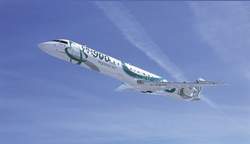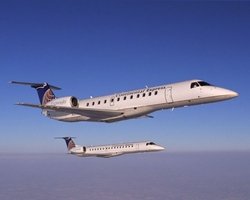RJs: 'Key to U.S. Industry Survival'
 U.S.
operators of Regional Jet aircraft now serve 223 North American
airports, with 26 receiving first-ever schedules during calendar
year 2002, according to a detailed analysis of the Regional Airline
schedule announcements undertaken by the Regional Air Service
Initiative (RASI). The expansion of RJ schedules at previously
served communities also grew rapidly during the past twelve months.
The number of different airline/hub options available at these
airports increased by 11% as Regional carriers added a significant
number of new nonstop service options to previously established
points.
U.S.
operators of Regional Jet aircraft now serve 223 North American
airports, with 26 receiving first-ever schedules during calendar
year 2002, according to a detailed analysis of the Regional Airline
schedule announcements undertaken by the Regional Air Service
Initiative (RASI). The expansion of RJ schedules at previously
served communities also grew rapidly during the past twelve months.
The number of different airline/hub options available at these
airports increased by 11% as Regional carriers added a significant
number of new nonstop service options to previously established
points.
 Nearly
one-half of all route announcements made in 2002 were for
first-ever nonstop flights.
Nearly
one-half of all route announcements made in 2002 were for
first-ever nonstop flights.
"Even as the Legacy Major carriers attempt to reconstitute
themselves as going concerns, Regional carriers continue to expand
the scope of service they provide to American cities by focusing on
the addition of new market-pairs, the majority of which were never
served nonstop before," said Doug Abbey, Executive Director of
RASI. He underlined: "Surprisingly, the number of routes where RJ's
replaced Major carrier jets accounted for only a small portion of
all new service, with about 9% of the total. This statistic
confirms there is little doubt that small capacity jets are
critical to the U.S. airline industry's growth and long-term
survival."
Think about how fast it's growing:
 In the period from January 1st to December 31st
2002, U.S. Regional carriers announced new RJ schedules on 183
airport-pairs -- at a rate of three-and-a-half per week. While the
vast majority of routes were hub-based, the small jet industry also
lived up to its promise of expanded point-to-point service options.
Examples of new direct routes included: Boston-Washington/National
(American Eagle and Delta Connection), Boise-Phoenix (Horizon), and
Tallahassee-Tampa (AirTran JetConnect).
In the period from January 1st to December 31st
2002, U.S. Regional carriers announced new RJ schedules on 183
airport-pairs -- at a rate of three-and-a-half per week. While the
vast majority of routes were hub-based, the small jet industry also
lived up to its promise of expanded point-to-point service options.
Examples of new direct routes included: Boston-Washington/National
(American Eagle and Delta Connection), Boise-Phoenix (Horizon), and
Tallahassee-Tampa (AirTran JetConnect).
First-ever nonstop schedules represented the largest category of
Regional Jet service announcements in 2002, accounting for nearly
one-half of all routes added in 2002. The second largest group,
termed "turboprop upgrade/replacement," represented 17% of all new
RJ service. A brand new category followed -- defined as "RJ Growth"
-- where new 70-seat aircraft were used to replace/supplement
50-seaters for the first time. Some 27 different routes fell into
this category, or 14.8% of the total.
Turbofan aircraft were also instrumental in expanding the scope
of Regional Airline service options by flying increasingly longer
stages. The average new route was 544 miles. Of the total, more
than one-half of all RJ service announcements in 2002 were on
routes 750 miles or greater. Nine of the new routes exceeded 1,000
miles, including the longest: Newark - Oklahoma City at 1,325
miles. Regional Jets continued their role as turboprop aircraft
replacements by also flying relatively short stages. Among the very
shortest, was Newark-White Plains, at 35-miles.
 Major Carrier Scope Clauses (contracted limits to
Regional Jet operations) had a significant impact on the individual
carriers making new service announcements. Given its relatively
liberal agreement, Delta Connection carriers accounted for a
majority of new routes, with nearly 47% of the total. Northwest
Airlink ranked second, with 19 announcements, followed by
Continental Express with 18. USAirways Express, by contrast,
planned only seven new RJ routes.
Major Carrier Scope Clauses (contracted limits to
Regional Jet operations) had a significant impact on the individual
carriers making new service announcements. Given its relatively
liberal agreement, Delta Connection carriers accounted for a
majority of new routes, with nearly 47% of the total. Northwest
Airlink ranked second, with 19 announcements, followed by
Continental Express with 18. USAirways Express, by contrast,
planned only seven new RJ routes.
During the past year, first-ever Regional Jet service was
introduced to 26 airports by U.S. Regional carriers, growing the
total number of points served by RJ's to 233. These new
destinations, generally smaller in population and which have
traditionally relied exclusively on turboprop aircraft schedules,
included such communities as Victoria, Texas; Huntington, West
Virginia; and San Luis Obispo, California.
 Expansion of RJ service to previously served
points also continued apace. On average, U.S. spoke airports
recorded an 11% increase in the number of hub and carrier options
provided by Regional Jets at their local airport. Among the
communities receiving the greatest absolute increases were Wichita,
Kansas and White Plains, New York -- both doubling from five RJ
hub/carrier options to ten. Colorado Springs, Colorado also saw
five new options added.
Expansion of RJ service to previously served
points also continued apace. On average, U.S. spoke airports
recorded an 11% increase in the number of hub and carrier options
provided by Regional Jets at their local airport. Among the
communities receiving the greatest absolute increases were Wichita,
Kansas and White Plains, New York -- both doubling from five RJ
hub/carrier options to ten. Colorado Springs, Colorado also saw
five new options added.
Among U.S. RJ hubs operating for at least one year, two operated
by Delta (Atlanta and Dallas/Ft. Worth) produced the greatest
expansion in the number of Regional Jet spokes served, with 26 and
25 new markets added respectively in 2002. On the basis of percent
growth, the number of RJ markets served by United Express at San
Francisco surged 300% (from one to four), followed by America West
Express at Phoenix, up 121% (from 17 to 34). During the year 2002,
Cincinnati became the first U.S. Regional Jet hub to sustain more
than 100 nonstop destinations.
Six new Regional Jet hubs were launched in 2002 including two by
Low Cost carriers: AirTran JetConnect at Atlanta and Frontier
JetExpress at Denver. Major carriers also introduced RJ schedules
at several new mini-hubs during the year, including Raleigh/Durham
and Los Angeles (American), Las Vegas (America West) and Los
Angeles (United). A total of 39 routes were represented by these
new operations.
 ANN's Daily Aero-Term (04.25.24): Airport Rotating Beacon
ANN's Daily Aero-Term (04.25.24): Airport Rotating Beacon ANN's Daily Aero-Linx (04.25.24)
ANN's Daily Aero-Linx (04.25.24) Klyde Morris (04.22.24)
Klyde Morris (04.22.24) Airborne 04.24.24: INTEGRAL E, Elixir USA, M700 RVSM
Airborne 04.24.24: INTEGRAL E, Elixir USA, M700 RVSM Airborne 04.22.24: Rotor X Worsens, Airport Fees 4 FNB?, USMC Drone Pilot
Airborne 04.22.24: Rotor X Worsens, Airport Fees 4 FNB?, USMC Drone Pilot







